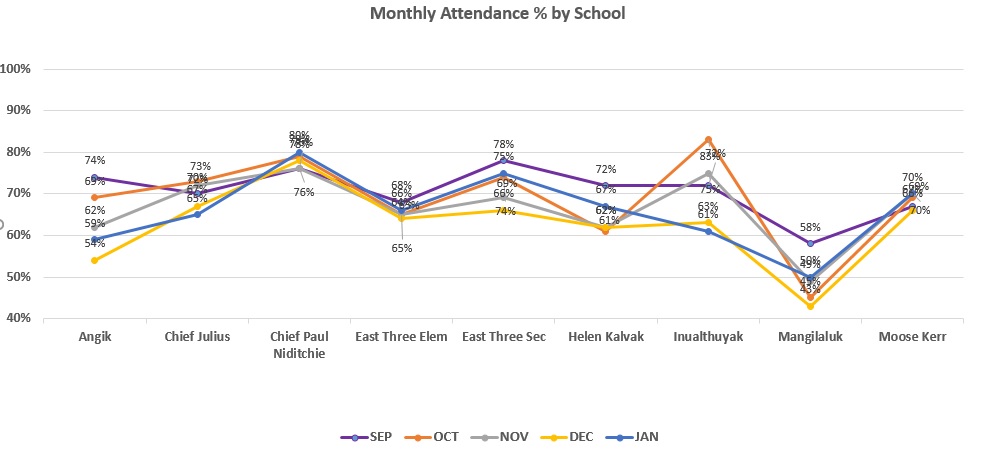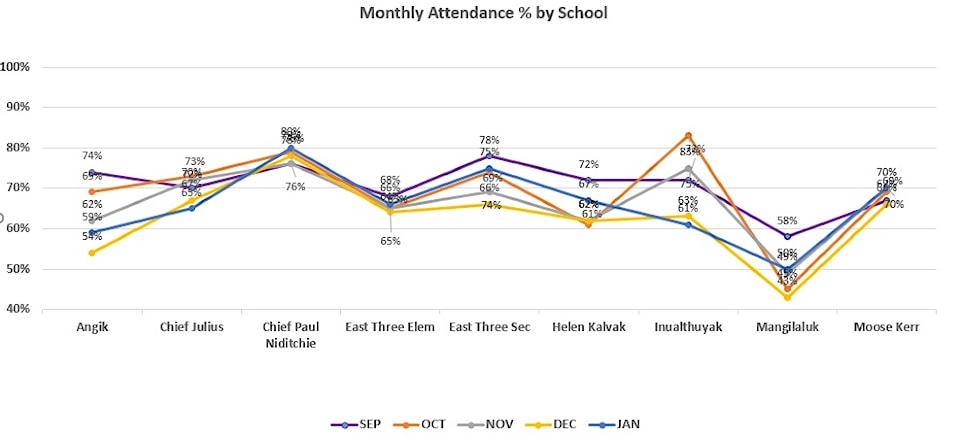A noticeable decline in attendance — particularly at the elementary level — over the first half of the 2020-2021 school year is being attributed to concerns of parents about the Covid-19 virus.
However, by March school board officials said numbers had rebounded to more normal levels.
"We have noticed an increase in attendance from January to March 2021," acting superintendent Devin Roberts told Inuvik Drum. "As schools implemented their COVID 19 reopening plans in a safe way, more and more families are beginning to feel safer about sending their children."
Roberts said attendance levels across the district increased four per cent in December, increasing from 68 per cent attendance to 72 per cent in January.

Photo courtesy Beaufort Delta District Education Council.
Agnik school averaged just 65 per cent attendance between September and January, whereas Chief Julius School averaged 70, Chief Paul Nidtichie averaged 78 per cent, East Three Elementary averaged 66 per cent and the high school averaged 73 per cent.

Photo courtesy Beaufort Delta District Education Council.
Helen Kalvak school averaged 65 per cent, Inualthuyak school averaged 71 per cent, Mangilaluk averaged 50 per cent and Moose Kerr averaged 69 per cent attendance.
Beaufort Delta District Education Council superintendent Frank Galway told attendees of the BDDEC 2021 AGM Feb. 17 the schools would continue an outreach program to get kids back to school.
"We have an attendance problem, I think, almost everywhere," said Galway. "We should be looking at 90 per cent attendance for every school."
Galway said the usual attendance rate at the start of the year was between 78 to 80 per cent, but in 2021 the average dropped to 67 per cent. He added a couple of committees had been set up to encourage parents to send their kids back to school, with the support of local District Education Authorities.
He observed some parents were keeping their students at home because of concerns surrounding the Covid-19 pandemic. Schools shut down in March last year when the World Health Organization declared the Covid-19 pandemic and re-opened using safe distancing regulations and using the school's gymnasium, as well as class space at Aurora College, to host classrooms.
Galway noted the main reason East Three was able to have in-person classes was because it was able to spread students out using the college's space.
However, the schools, particularly East Three, may have to re-examine those policies too, as Galway told the board Aurora College intended to resume in-person classes in the fall and the space would not be available for BDDEC.
He noted the chances of restrictions being lifted for public schools were slim as well, because Covid-19 vaccinations are currently only available to people over 18 years old.
Roberts told the board attendance will be a major plank in BDDEC's five year plan, which a working group has been set up with the Inuvialuit Regional Corporation, the Gwich'in Tribal Council and the District Education Council has begun preparing.
"This adds up, if you look over the years — if a child misses 20 per cent of the time, by year five they've missed an entire year of their schooling," said Roberts. "We were concerned with attendance prior to Covid-19, now we're really concerned."


